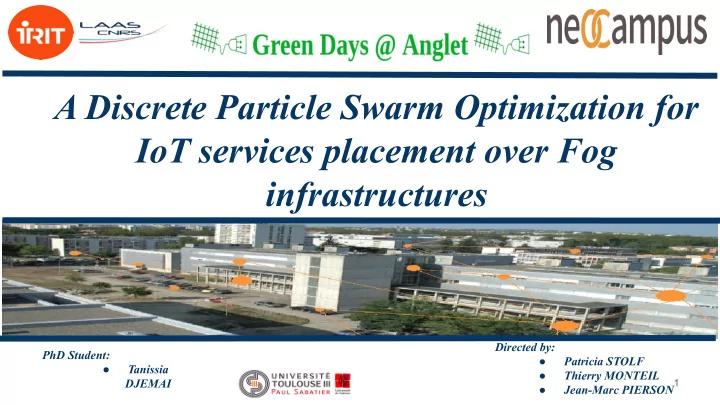

A Discrete Particle Swarm Optimization for IoT services placement over Fog infrastructures Directed by: PhD Student: ● Patricia STOLF ● Tanissia ● Thierry MONTEIL DJEMAI 1 ● Jean-Marc PIERSON
Outline Experimental Problem Introduction Conclusion Strategies approach & formulation results ● Smart cities ● ● Fog hierarchical CloudOnly ● Current Work ● Methodology ● Internet of Things Infrastructures ● FogOnly ● Future ● Results applications ● ● IoT applications FogCloud prospects ● Large scale graphs ● IoTCloud computing ● ● Objective DCT infrastructures function ● DPSO 2
Introduction Heterogeneity 25% Dynamicity (thesis context ) Users number Energy greedy 28% 47% Experimental approach Conclusion 3 Introduction Problem formulation Strategies & results
Fog Infrastructures “Fog computing is a horizontal, physical or virtual resource paradigm that resides between smart end-devices and traditional cloud or data centers.” [NIST 2017] Experimental approach Conclusion 4 Problem formulation Introduction Strategies & results
IoT applications S S S 1 2 0 S 3 S 2 S S 4 0 S 1 Experimental approach Conclusion 5 Problem formulation Introduction Strategies & results
Energy & delay violation S S S 1 2 0 S S 3 2 S S 4 0 S 1 S S S 1 2 0 S 2 S S 1 4 S S 2 0 S S 1 0 Experimental approach Conclusion 6 Problem formulation Introduction Strategies & results
Discrete Particle Swarm Optimization approach Experimental approach & Conclusion 7 Strategies Introduction Problem formulation results
START 1. Initialize all particles uniformly 2. Initialize velocities to 1 3. Evaluate fitness for each particle Xk 4. Update Personal best (pb) 5. Update ring neighbor best (nb) 6. Update velocity 7. Update particle position No Is max iterations reached? Yes STOP Experimental approach & Conclusion 8 Strategies Introduction Problem formulation results
CloudOnly IoTFogOnly IoTCloud(IC) FogCloud(FC) Dicothomous (DCT) Discret Particle Swarm Optimization (DPSO) Experimental approach & Conclusion 9 Strategies Introduction Problem formulation results
S S S 1 2 0 S 2 S 0 S 1 (1) Real Time (RT) (2) Mission Critical (MC) (3) Streamin (ST) (4) Best Effort (BE) Experimental approach & Conclusion 10 Strategies Introduction Problem formulation results
Experimental approach & Conclusion 11 Strategies Introduction Problem formulation results
12
Conclusion (1) 1. Evolutionary approach and basic placement strategies. 2. DPSO gives a good tradeoff between energy and delay values. 3. Execution time. 4. Centralized approach. 5. Hierarchical topology. 6. Linear energy consumption profile. 7. Static infrastructure and VMs. 13
Conclusion (2) Experimental approach & 14 Strategies Introduction Problem formulation Conclusion results
Conclusion (3) Solution quality impacted by time. Users mobility estimation Efficient handover and migrations approches Evaluation Services availability. Experimental approach & Conclusion 15 Strategies Introduction Problem formulation results
BIBLIOGRAPHY [1] Z. A. Bonomi, Milito. Fog computing and its role in the internet of things.MCC’12, August 17, 2012, Helsinki, Finland, -1, 2012. [2] C. company. Cisco fog computing with iox.IEA 4E EDNA, Technology and Energy Assessment Report, -1, 2014. [3] L. L. Giang, Blackstock. Developing iot applications in the fog: a distributed dataflow approach.5th International Conference on the Internet of Things (IoT), 2015. [4] G. B. Gupta, Dastjerdi. ifogsim: A toolkit for modeling and simulation of resource management techniques in the internet of things, edge and fog computing environments.IEEE, -1, 2016. to appear. [5] B. M. G. M. Iorga, Feldman. Fog computing conceptual model recommendations of the national institute of standards and technology.NIST Special Publication 500-325, -1, 2017. 16
Recommend
More recommend